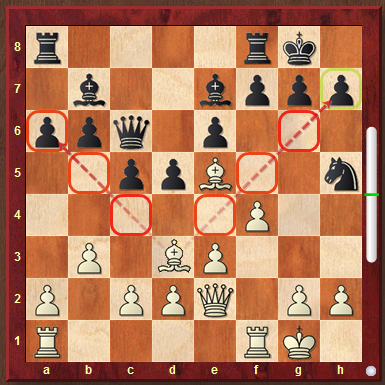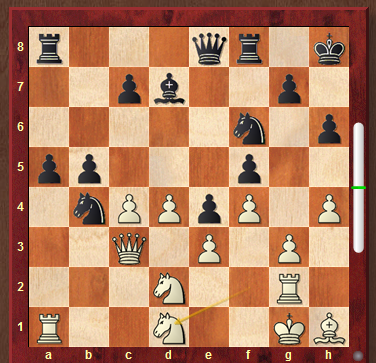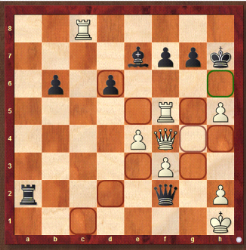|
Assisted Analysis |

|

|
|
|
Assisted Analysis |

|

|
Assisted Analysis
The function “Assisted Analysis”, implemented for the first time in ChessBase 14, offers the user, either when entering moves or when playing through a game, valuable hints about the tactical consequences of a possible move. It does so by means of coloured highlights on the chess board.
The basic idea behind this feature is that present day chess engines on high-performing hardware come up with the best move in mere milliseconds. Unlike in classical engine analysis (Infinite analysis), in which the evaluation of the move is displayed in the engine window, the user does get hints about the quality of a specific continuation, but in the final resort he has to investigate for himself the reason for the evaluation.
This way of working is significantly more stimulating for the development one’s own tactical abilities and that circumstance makes this function so valuable for chess training.
Assisted Analysis can be activated both in analysis mode and in the playing mode Easy Game.
Let us take a look at the function by means of some examples taken from games.
Lasker – Bauer - Amsterdam 1889

After some very passive play by Black in the opening the white pieces are poised for an attack. Lasker now begins the decisive attack. How might that attack be pursued?
A click on the white bishop on d3 beings up with coloured highlights a display of the possible squares that selected piece could go.

The coloured highlights refer to the evaluations made by the chess engine which is calculating in the background. In this case interpretation is easy. Most squares to which the Bd3 could go to are highlighted in red, red meaning a very bad move. In this example, specifically material is lost without compensation. Target squares highlighted in green, on the other hand, are promising and suggest a good move. Here Assisted Analysis is making a case for the bishop sacrifice on h7, exactly the continuation selected by Lasker in the game.
So, specifically which coloured highlights and hints to the user are being offered by the function?
| • | Green – a very good move. |
| • | Yellowish green – playable, but not the best move. |
| • | Yellow – this move is tactically playable, but by far not the best move. |
| • | Orange – still tactically playable, but not a particularly good move. |
| • | Red – a very bad move! |
A further example:
Bogoljubov – Alekhine - Hastings 1922

White’s position looks terrible: he is a pawn down and his pieces have hardly any space to breathe. When you click on the Nb4 Assisted Analysis shows you the evaluations for its possible moves according to the table described above.

The move played by Alekhine in the game, to d3, is the one considered by the program to be the best continuation and highlighted in green.
In many positions you would like to know what specifically happens if a piece is moved to a square which the analysis function has highlighted as critical (red). Here too Assisted Analysis is of help with a cute piece of support for the user. It is possible to have the program display the reply immediately!
In our example the d5-square is highlighted as being critical. That is clear, since the piece can be taken at once.
But in many highly tactical positions things are not always so clear-cut. Let us take a look at how the reply to a move can be displayed by the analysis function.
In the example, move the piece to the square highlighted in red and press the right-hand button of the mouse without letting go of the piece.

The program then immediately displays the absolutely best counter-move!
Let us consider as our final example the following position:
Karjakin – Carlsen New York 2016
This position comes from the tiebreak between GM Carlsen (White) and GM Karjakin (Black) and finally decided the WCh match. It illustrates Assisted Analysis very well.

A click on the white queen here shows the squares to which it can go highlighted with the various colours. In the position Assisted Analysis highlights only one square in dark green, whereas the remaining moves are displayed with a deep reddish brown colour. The dark green highlight indicates a forced mate; the reddish brown highlighting of the remaining squares shows that if he makes one of these moves White will be mated. Here too, using the right-hand mouse button to see Black’s reply will serve to convince of this immediately.

So Assisted Analysis brings you the following advantages:
• you can recognise at first glance how to evaluate the quality of a move.
• when inputting moves you can concentrate completely on the chess board without constantly paying attention to the display provided in the evaluation pane by an engine which is running.
• the function stimulates the calculation of variations and thereby advances/trains the user’s chess ability.
Tip: Assisted Analysis is not compatible with one-click input. Whenever the function is active, frequently the most likely move is not played. The reason for that consists of the fact that Assisted Analysis leads to the user clicking on several pieces one after the other to check the quality of different moves.